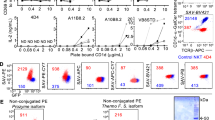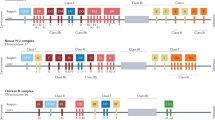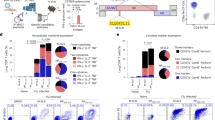Abstract
Most cellular interactions essential for the development of an immune response involve the membrane glycoproteins encoded in the major histocompatibility gene complex1–3. The products of the I region, the class II histocompatibility molecules (Ia molecules), are essential for accessory cells such as macrophages to present polypeptide antigens to helper T cells. This interaction, antigen presentation, is needed for T-cell recognition of the antigen and its consequent activation. How the Ia molecules regulate the immune response during antigen presentation is not known, although it is commonly thought to result from their association with the presented antigen1,4,5. Recent studies, including the elucidation of the structure of the T-cell receptor, favour recognition of a single structure, an antigen–Ia complex6–8. Here we report attempts to determine whether purified Ia glycoproteins have an affinity for polypeptide antigens presented by intact cells in an Ia-restricted manner. We first identified the epitope of a peptide antigen involved in presentation9. Several laboratories have shown that globular proteins are altered (processed) in intracellular vesicles of the antigen-presenting cell before antigen presentation10–12. A major component of the T-cell response is directed toward determinants found in the unfolded or denatured molecule, and our laboratory has shown that the determinant of the hen-egg lysozyme protein (HEL), presented in H–2k mice to T cells, is a sequence of only 10 amino acids9. This portion resides in an area of the native molecule partially buried inside the molecule, in a β-sheet conformation. To be presented, intact or native HEL must first be processed in acidic intracellular vesicles12. Having isolated the peptide responsible for T-cell recognition of HEL, we sought a physical association of this peptide with purified, detergent-solubilized I–Ak molecules from B-hybridoma cells. We have found such an association, which may explain the role of the Ia glycoproteins in cellular interactions.
This is a preview of subscription content, access via your institution
Access options
Subscribe to this journal
Receive 51 print issues and online access
$199.00 per year
only $3.90 per issue
Buy this article
- Purchase on SpringerLink
- Instant access to full article PDF
Prices may be subject to local taxes which are calculated during checkout
Similar content being viewed by others
References
Schwartz, R., Yano, A., Stimpfling, J. & Paul, W. J. exp. Med. 149, 40–57 (1979).
Unanue, E. R. Adv. Immun. 31, 1–135 (1981).
Rosenthal, A. S. & Shevach, E. M. J. exp. Med. 138, 1194–1212 (1973).
Schwartz, R. in Fundamental Immunology, 379–438 (Raven, New York, 1984).
Benacerraf, B. J. Immun. 120, 1809–1812 (1978).
Kappler, J. B., Skidmore, B., White, J. & Marrack, P. J. exp. Med. 153, 1198–1214 (1981).
Patten, P. et al. Nature 312, 40–46 (1984).
Chien, Y.-H. et al. Nature 312, 31–35 (1984).
Allen, P. M., Matsueda, G. R., Haber, E. & Unanue, E. R. J. Immun. 135, 368–373 (1985).
Ziegler, H. K. & Unanue, E. R. Proc. natn. Acad. Sci. U.S.A. 79, 175–178 (1982).
Chesnut, R., Endres, R. & Grey, H. M. Clin. Immun. Immunopath. 15, 397–408 (1980).
Allen, P. M. & Unanue, E. R. J. Immun. 132, 1077–1079 (1984).
Aboderin, A. A., Boedefeld, E. & Luisi, P. L. Biochim. biophys. Acta 328, 20–30 (1973).
Turkewitz, A. P., Sullivan, C. P. & Mescher, M. P. Molec. Immun. 20, 1139–1147 (1983).
Glimcher, L. H., Schroer, J. A., Chan, C. & Shevach, E. M. J. Immun. 131, 2868–2874 (1983).
Watts, T. H., Brian, A. A., Kappler, J. W., Marrack, P. & McConnell, H. M. Proc. natn. Acad. Sci. U.S.A. 81, 7564–7568 (1984).
Shimonkevitz, R., Colon, S., Kappler, J. W., Marrack, P. & Grey, H. M. J. Immun. 133, 2067–2074 (1984).
Clark, R., Chiba, J., Zweig, S. & Shevach, E. Nature 295, 412 (1982).
Hansburg, D., Heber-Katz, E., Fairwell, T. & Appella, E. J. exp. Med. 158, 25–39 (1983).
Rock, K. L. & Benacerraf, B. J. exp. Med. 157, 1618–1634 (1983).
Werdelin, O. J. Immunology 129, 1883–1891 (1982).
Frelinger, J. G. et al. J. exp. Med. 159, 704–715 (1984).
Glimcher, L. H., Serog, B., McKane & Beck, B. N. J. Immun. 134, 1780–1786 (1985).
Pierres, M., Devaux, C., Dosseto, M. & Marchetto, S. Immunogenetics 14, 481 (1981).
Allen, P. M., Strydom, D. J. & Unanue, E. R. Proc. natn. Acad. Sci. U.S.A. 81, 2489–2493 (1984).
Watanable, Y. & Imai, K. Analyt. Biochem. 116, 471–472 (1981).
Author information
Authors and Affiliations
Rights and permissions
About this article
Cite this article
Babbitt, B., Allen, P., Matsueda, G. et al. Binding of immunogenic peptides to Ia histocompatibility molecules. Nature 317, 359–361 (1985). https://doi.org/10.1038/317359a0
Received:
Accepted:
Issue Date:
DOI: https://doi.org/10.1038/317359a0



